[Here’s a link to other forays around my map.]
A foray today to the outer fringes of my map and, travelling there, a sinking feeling that a single map is far too big for a lifetime of exploring! But I shall do my best…
A sweaty man ran towards me, suffering from the exertions of his morning run. I stepped aside on the flagstones of the church path to let him past. But instead he just touched the yew tree and ran back the way he had come. This tree must be his regular ‘turnaround’ spot. It was my starting spot for today’s grid square. If I was the sort of man who had a Top 10 ranking of trees in my head –and I am that sort of man– then I’d score the yew way down my list. It looks gloomy, it sucks away the sunshine, and it is hard to climb.
Perhaps I am being unfair. Yews grow for an impressively long time (estimates suggest the Fortingall yew in Glen Lyon could be anything from over two thousand to nine thousand years old.), and Britain, for once, is home to far more ancient yews than any other country in Europe. The Ancient Yew Group has identified 978 ancient or veteran yews (more than 500 years old) in England and 407 in Wales; France has 77; Germany and Spain just four each. It is notoriously difficult to determine the age of an old yew, and extravagant claims about such trees abound, but several experts have put the Defynnog yew at more than 5,000 years old – as ancient, if not more so, as another churchyard yew at Fortingall, Scotland. Other authorities suggest it is a mere 1,500 years old but even if it isn’t the oldest living thing in Europe, this unique tree currently has less legal protection than any of the estimated 530,000 listed buildings, including bus stops and skate parks, in England and Wales.
The yew tree is another of our native trees which the Druids held sacred in pre-Christian times. They no doubt observed the tree’s qualities of longevity and regeneration. Drooping branches of old yew trees can root and form new trunks where they touch the ground. Thus the yew came to symbolise death and resurrection in Celtic culture.
The Celts will also have been familiar with the toxicity of the tree’s needles in particular. This may have further contributed to its connections with death. Shakespeare was familiar with these qualities when he had Macbeth concoct a poisonous brew. The deadly drink included “slips of yew, silvered in the moon’s eclipse”. The very hard, close-grained wood was used in furniture making. But yew wood is perhaps best known as the material from which the medieval English longbows were made. Archers used these to devastating effect during the Hundred Years War.
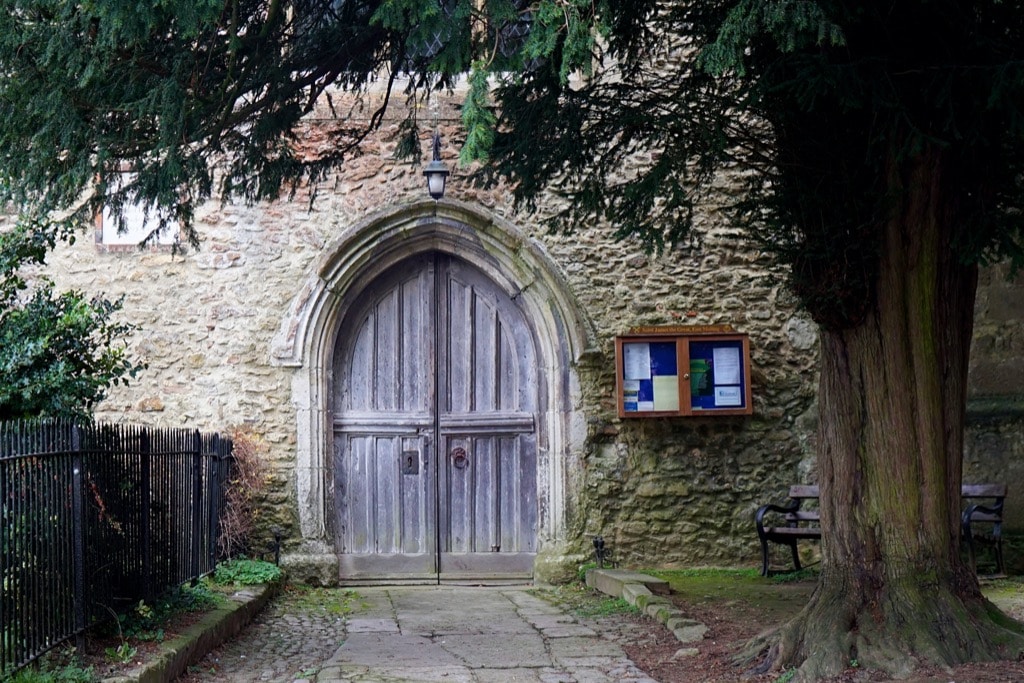
Any old church and graveyard hides countless stories, and I only have four hours to explore my grid square today. The weathered, arched oak church door is locked anyway. And I do my best to resist my usual urge to read every inscription in the graveyard, telling myself I will have to settle for a quick stroll today.
I love gravestones. They stir my imagination. I like to calculate the ages of people, feel sad about those who died young, pause at those who die around my age, and wonder about all those husbands and wives ‘reunited at last’. I walk past simple wooden crosses. There’s one for ‘”Mick”, Micheal [sic] Miller, Lost Not Forgot” with a statue of a fat, smiling, wandering Budai. Another is “In Loving Memory of Hazel, Mum and Nan, Bill, Dad and Pops” with a simple drawing of a football and a flower. There are well-tended plots with little white railings, heaps of flowers, little statues of rabbits and deer, and photos of Mum and Nan. And there is Bill and his “old sweetheart” Jean.
There are upright headstones, flat headstones, kerbed headstones, and table tombs. They are polished, part-polished, honed, and pitched. And, eventually, they are faded, moss-covered, and fall over. I think about the dash poem and why, if I love graveyards, do I hope that when I die my ashes are sprinkled into a swift stream at dawn on a sunny day and that’s the end of that and everyone goes home and gets on with life?

Attempting to lighten my mood I make my way to the village green, where I come across a war memorial for the dozens of young men from this village killed in the First World War. I wonder whether there’ll be a single village on my map without such a memorial. This seems unlikely, sadly. The ‘Thankful Villages’ are those from which all their members of the armed forces survived World War I. There are tens of thousands of villages and towns in the United Kingdom. But there are just 53 civil parishes in England and Wales from which all serving personnel returned. There are no Thankful Villages identified in Scotland or Ireland yet. Fourteen of the English and Welsh villages are considered “doubly thankful”, in that they also lost no service personnel during World War II.
In France, where the human cost of war was higher than in Britain, Thierville in Upper Normandy was the only village in all of France with no men lost from World War I. Thierville also suffered no losses in the Franco-Prussian War and World War II, France’s other bloody wars of the modern era.

Fortunately the bus shelter on the village green could cheer me up, for someone had donated a pile of books to help people pass the time waiting for their hopelessly infrequent local bus service. Opposite the pub was a beautiful timber-framed home, a Yeoman’s hall, dating from the 15th Century. These were so-called because they were built around a large hall, with a hearth for a fire in the centre. They were usually built by a farmer who owned his own land, known at that time as a “yeoman”. I wonder what he would have made of the food now on offer next door to his house, for an Indian Takeaway was offering Tiffin Box Meal Deals. Tiffin boxes are a neat stack of three or four metal containers, like a fancy packed lunch box. Famous in Mumbai are the Dabbawallas who collect these towers of fresh-cooked deliciousness from people’s homes, deliver them to the hungry worker at lunchtime, then return the empty containers later.
The 5,000 or so dabbawalas in the city have an astounding service record. Every working day they transport more than 130,000 lunchboxes throughout Mumbai, the world’s fourth-most-populous city. That entails conducting upwards of 260,000 transactions in six hours each day, six days a week, 52 weeks a year (minus holidays), but mistakes are extremely rare. Amazingly, the dabbawalas—semiliterate workers who largely manage themselves—have achieved that level of performance at very low cost, in an ecofriendly way, without the use of any IT system or even cell phones.
The dabbawala service is legendary for its reliability. Since it was founded, in 1890, it has endured famines, wars, monsoons, Hindu-Muslim riots, and a series of terrorist attacks. It has attracted worldwide attention and visits by Prince Charles, Richard Branson, and employees of Federal Express, a company renowned for its own mastery of logistics.
On any given day, a tiffin box (dabba) changes hands several times. In the morning a worker picks it up from the customer’s home and takes it (along with other dabbas) to the nearest train station, where it is sorted and put onto a wooden crate according to its destination. It is then taken by train to the station closest to its destination. There it is sorted again and assigned to another worker, who delivers it to the right office before lunchtime. In the afternoon the process runs in reverse, and the dabba is returned to the customer’s home.

An interesting feature of villages in the south of England is that, radiating out from the old centre, the types of houses change so dramatically with all the new building that has gone on. From the pastoral village green with its church, pub, and nice old homes, I moved out into different housing estates, built one by one over the past few decades, each with its own style of homes. Long ago a report recommended housing in short terraces, spaced 70 feet apart at a density of 12 per acre. The First World War indirectly provided a new impetus, when the poor physical health and condition of many urban recruits to the army was noted with alarm. This led to a campaign under the slogan “Homes fit for heroes”.
Then during the Second World War almost four million British homes were destroyed or damaged, and afterwards there was a major boom in council house construction. The bomb damage from the war only worsened the condition of Britain’s housing stock, which was in poor condition before its outbreak. Aneurin Bevan promoted a vision of new estates where “the working man, the doctor and the clergyman will live in close proximity to each other”.
Since then the approach to home-building see-saws from government to government. The debate on public housing provision is politically polarised. The left see council estates as a great achievement, while successive Conservative administrations attempt to curb their spread and restrict the essential funding for maintenance.

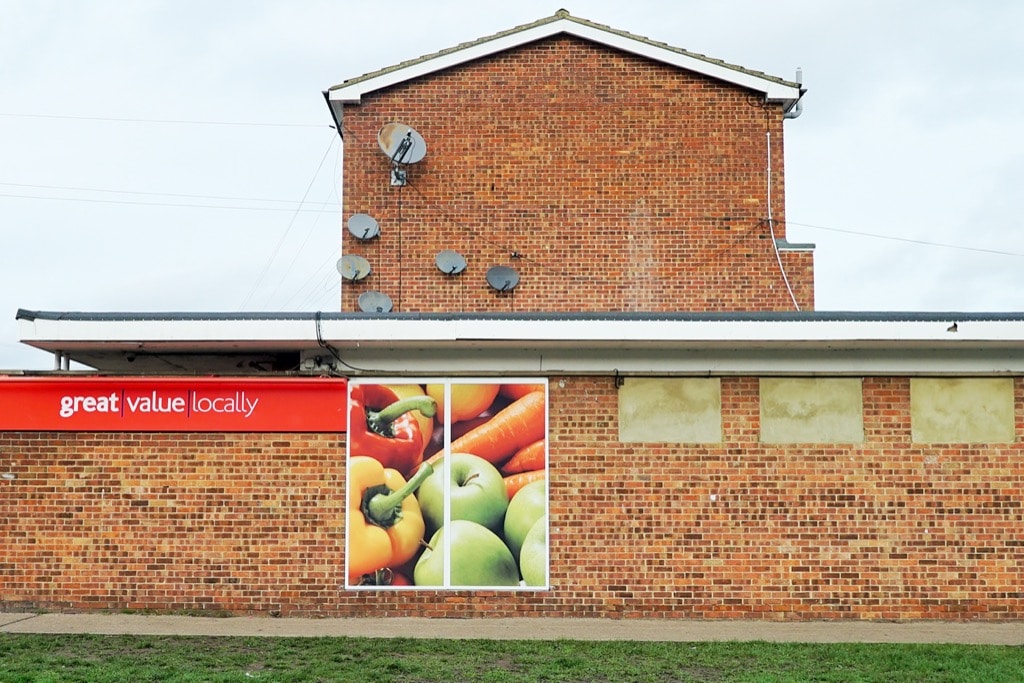
Regardless of where I am I love strolling around houses and marvelling at the sheer number of families and lives and stories they contain. (If you feel the same way you might enjoy reading The People of Providence.) Maisonettes, blocks of flats, cookie cutter family homes, a house-proud garden alongside a tangle of weeds and rubbish, and the wonderful bungalow of Sheila and Malc, their names proudly hand-carved on a wooden arch in their small but flower-filled garden. Many of the streets were named after fields, meadows and trees, a reminder that not so long ago this all used to be natural, wild, empty. Now there’s a man mowing his lawn five weeks before Xmas.
Incongruous amongst all the new homes was a tiny old lodge house, a single storey with two windows, a front door between, and a triangular roof. As I prepared to take a photo a work van braked hard on the road. “Don’t take fucking photos!” shouted the driver. “Why not?” I asked. “Because it’s my house,” he lied, and roared off. I shrugged and took my photo.
I stopped outside a parade of shops, ideally positioned to serve the local community. On offer, as well as a convenience store and a Post Office were:
- Holap House, English and Chinese hot food
- Charcoal grill Est:2002
- Safron (sic) Indian takeaway
- Pinx Beauty and Tanning
- Eclipse unisex hairdressing
Three takeaways, a beauty studio, and a hairdresser. Apart from America, does any other country have such a crap approach to community and food? (Not a rhetorical question! Let me know in the comments.)


Much of my grid square was occupied by orchards that are part of a century-old fruit research station. Over the years, some of the finest and most important research on perennial crops has been conducted on the site resulting in a world-wide reputation. Some of the more widely adopted developments have been achieved in the areas of fruit plant culture (especially the development of rootstocks), agronomy, fruit breeding, post-harvest storage and the biology and control of pests and diseases.
Today, the science and research is applied to a much wider range of crops than fruit trees and bushes, and includes mushrooms, tomatoes, bulbs, herbs and ornamental shrubs.
You can’t just grow an apple by spitting out a pip (you often end up with a crabapple tree when you plant an apple seed). Apples must be propagated clonally by grafting and for many years the research station produced large numbers of rootstocks for the industry (in 1921 = 15,000 and by 1936 = 500,000). Work looking at the biological processes associated with root development, cutting establishment and graft union formation was undertaken as well as looking at practical considerations such as optimal environmental conditions. New, more successful Double Shield and Chip budding techniques were developed. Robert Garner, in charge of rootstock propagation produced ‘The Grafter’s Handbook’. EMLA stock and micro-propagated material also provided a reliable source of virus free rootstocks for the growers.
The Malling (M) series of rootstocks are used in virtually every part of the world where apples are grown commercially and it is estimated that 90% of apple orchards in Western Europe are grafted onto M9.
There’s a lot to be said for domestication. Though Henry David Thoreau insisted that he much preferred the wild apple (“of spirited flavor”) to the civilized versions found in Massachusetts orchards, even he admitted that the occasional spirited bite was “sour enough to set a squirrel’s teeth on edge and make a jay scream.” The truth is that wild apples – grown from seeds—are generally pretty awful.
Several recent genetic studies have demonstrated that the modern apple is a hybrid of at least four wild apple populations, and researchers have hypothesized that the Silk Road trade routes were responsible for bringing these fruits together and causing their hybridization. Archaeological remains of apples in the form of preserved seeds have been recovered from sites across Eurasia, and these discoveries support the idea that fruit and nut trees were among the commodities that moved on these early trade routes.
Large fruits are an evolutionary adaptation to attract large animals that can eat the fruits and spread the seeds. Certain large mammals, such as bears and domesticated horses, eat apples and spread the seeds today. However, prior to the end of the last Ice Age, there were many more large mammals on the European landscape, such as wild horses and large deer. So ultimately, the apple in your kitchen appears to owe its existence to extinct megafaunal browsers and Silk Road merchants.
That, plus the boffins hard at work in my grid square.

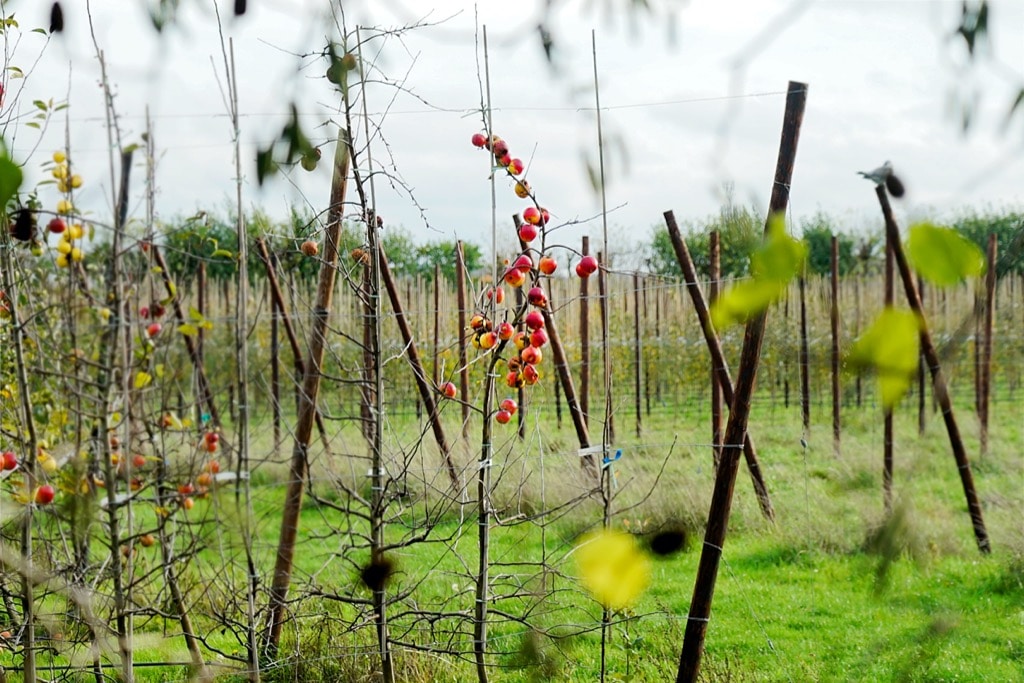
I sat in the orchard and ate my banana, looking up at a silver maple tree whose branches were almost bare but for many large clumps of mistletoe. Not surprising, perhaps, for its favourite host is cultivated apple – about 50% of British Mistletoe grows on this tree. The evergreen mistletoe is ‘hemiparasitic‘, which means it takes some of its food from another plant. It grows on the branches of trees, pulling water and nutrients from its host, while its green leaves also photosynthesise. Despite growing on trees, mistletoe is not generally found in a woodland setting, preferring hosts in open situations with plenty of light. You’re more likely to see it in gardens, orchards, parkland and even churchyards. This means that mistletoe would have been less abundant in ancient times when woodland was more typical. European mistletoe needs little management where it is on a large tree (e.g. tall limes) but must be actively managed on smaller trees (e.g. apple trees). As parasites they do, of course, seriously distort and suppress the host branch they grow on. That’s not a problem if just a few branches are affected – but if the mistletoe becomes established on every branch it’s bad news for the tree and, ultimately, the mistletoe.
In recent years, mistletoe’s range in the UK has begun to expand, particularly into eastern areas of England. This may be due in part to an influx of continental blackcaps from Germany that have started overwintering in Britain, with many thousands now spending their winters here.
Blackcaps are migratory warblers that are becoming regular winter visitors to our bird tables. Berries, including those of mistletoe, are an essential part of their diet. On eating the white flesh of the mistletoe berry, the birds wipe their bills on twigs and branches, leaving behind the seed. If the seed is deposited on a host tree and manages to take hold, a mistletoe plant might germinate on the branch. It seems that blackcaps are more efficient at spreading mistletoe seeds than other birds, such as the mistle thrush, which also feed on the berries.
I had always assumed mistletoe to be harmful. But European mistletoe has a long history in herbal medicine and even as a winter fodder crop – so it’s not as bad as many think. It is definitely NOT edible for humans – but it is eaten readily by livestock when they can reach it. Small quantities eaten by livestock should not be a problem, but large quantities should be avoided.
Dried mistletoe is widely available as a therapeutic herbal tea in continental Europe, but hasn’t caught on in Britain. This is a shame because the druid Getafix harvests in the way described by Pliny, cutting the mistletoe with his golden sickle and using it to make special potions which famously gives his Gaulish tribe superhuman strength.
Kissing under sprigs of mistletoe is a well-known holiday tradition, but this little plant’s history as a symbolic herb dates back thousands of years. Many ancient cultures prized mistletoe for its healing properties. The Greeks were known to use it as a cure for everything from menstrual cramps to spleen disorders, and the Roman naturalist Pliny the Elder noted it could be used as a balm against epilepsy, ulcers and poisons. The plant’s romantic overtones most likely started with the Celtic Druids of the 1st century A.D. Because mistletoe could blossom even during the frozen winter, the Druids came to view it as a sacred symbol of vivacity, and they administered it to humans and animals alike in the hope of restoring fertility.
The custom of kissing under Mistletoe comes from England. The earliest recorded date mentioning kissing under the mistletoe is in 1784 in a musical. There was kissing under the mistletoe in the illustrations in the first book version of ‘A Christmas Carol’ published in 1843, and this might have helped to popularise kissing under the mistletoe. The original custom was that a berry was picked from the sprig of Mistletoe before the person could be kissed and when all the berries had gone, there could be no more kissing!
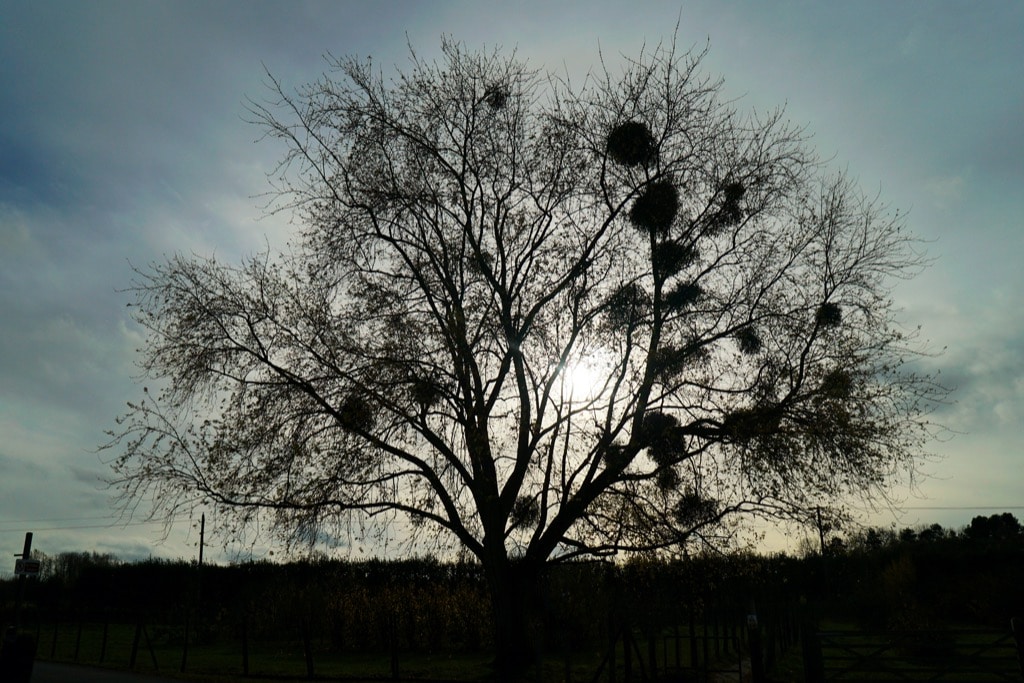
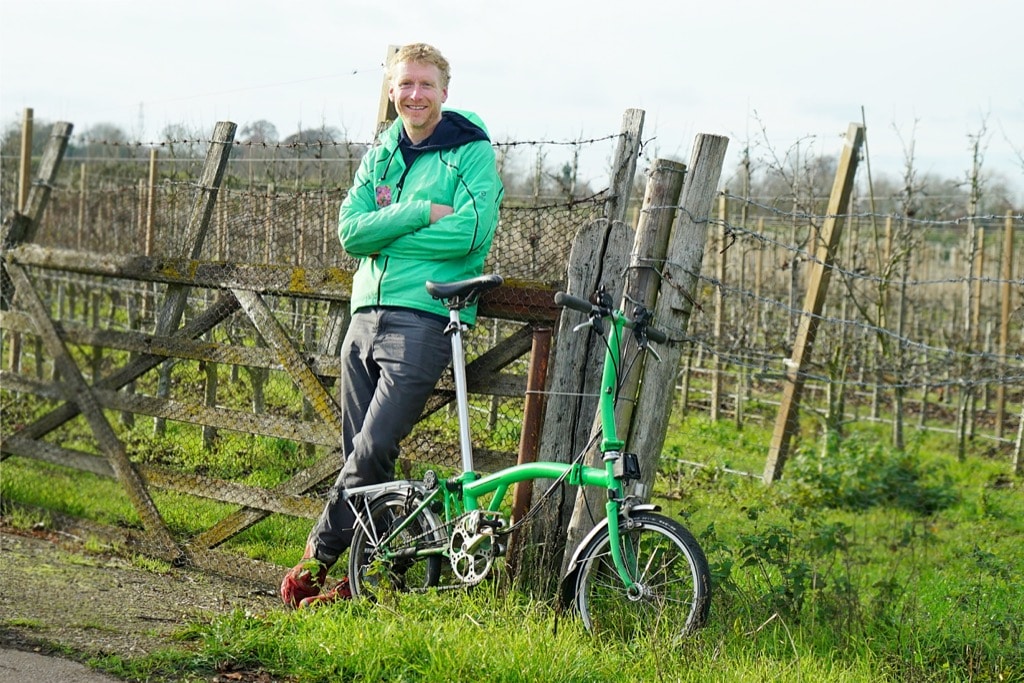
And that was about it. The orchards were all fenced off and there was not much else to explore. I was happy to see and hear my first fieldfares, and added ‘Large Fries’ to my menu of McDonalds’ litter seen on my wanderings. I spotted the first fish on my map, with a lively school of dace sheltering in a small stream’s shade under a bridge. Small brown trout nosed into the current, hovering with a gentle flicking of their tales. It must be like living on a treadmill. A fierce predator of small fish and flying insects, the brown trout is widespread in our freshwater rivers. It is has a golden body, flanked with pale-ringed, dark spots. It made me happy, after the takeaways and prim, fenced in fields, to know that even in this fairly bland grid square I was in the company of ‘fierce predators’.
I wonder what I will find in my next grid square. Why don’t you try this project wherever you happen to live?
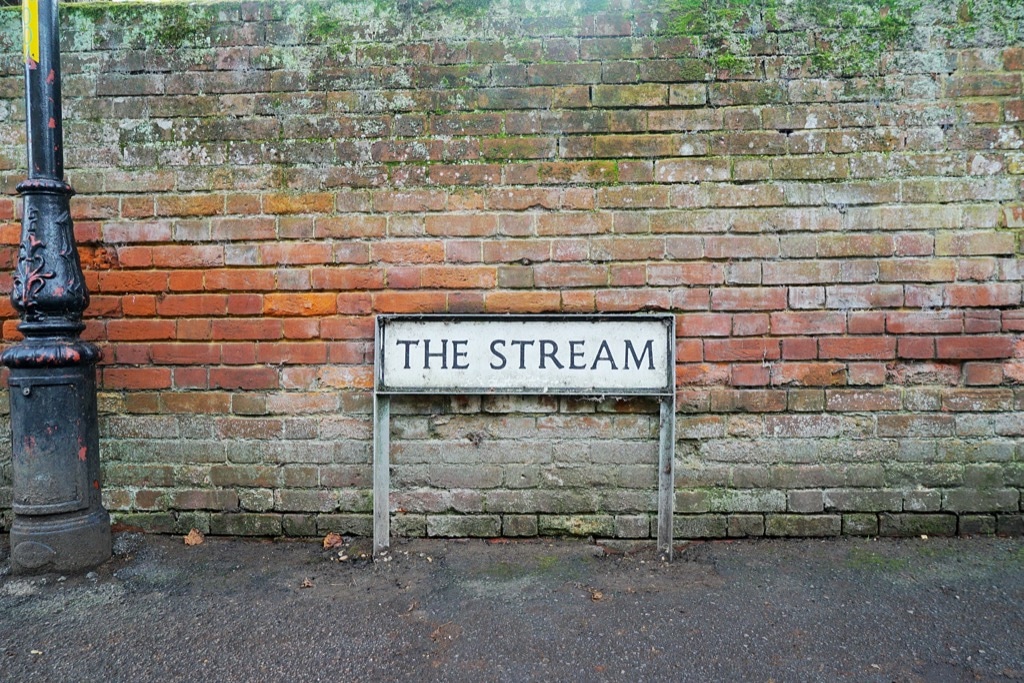
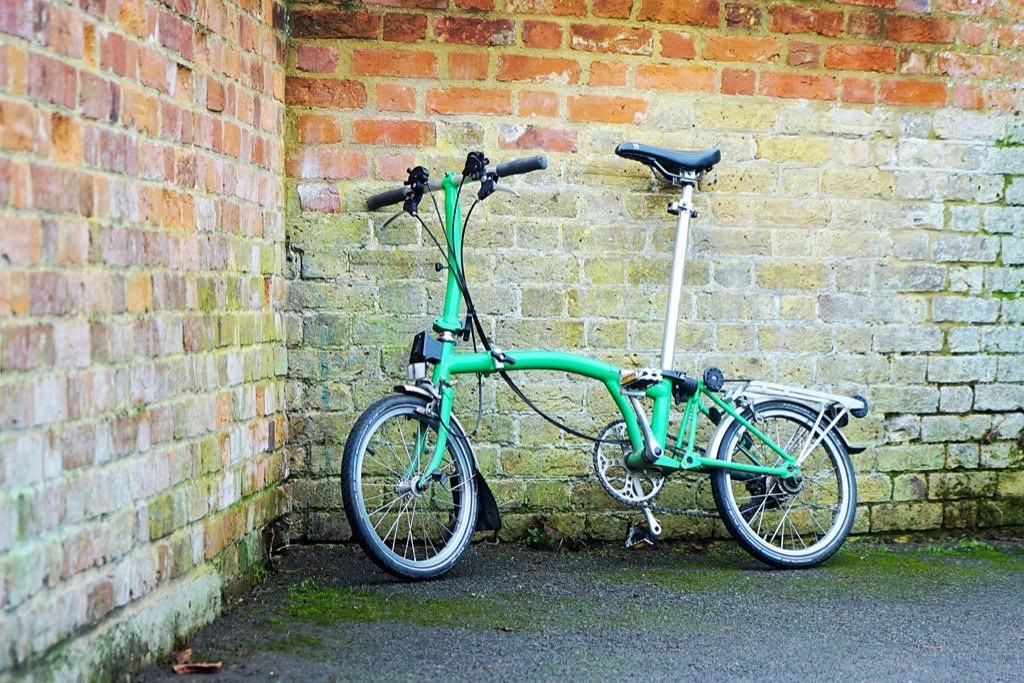




I did my first two squares today on my bike.
The first was the centre square which was the next square to a cafe. Hot chocolate and toast put some warmth back in my fingers. Onto the main feature of the square which was an unmanned rural sewage farm. I was hoping for something Victorian in two tone brick but it was very modern and galvanised steel.
Found a couple of never before used lanes (by me) and a bridlepath with a potential for bivvying in the Spring and into my second square where a small bridge over the Smestow Brook, a low sun, and mist in the trees made for a ‘nice’ photo. Off home for just 25 cold kms done.
Thanks for the inspiration.
VERY COOL! I’m delighted that you are giving this a try.